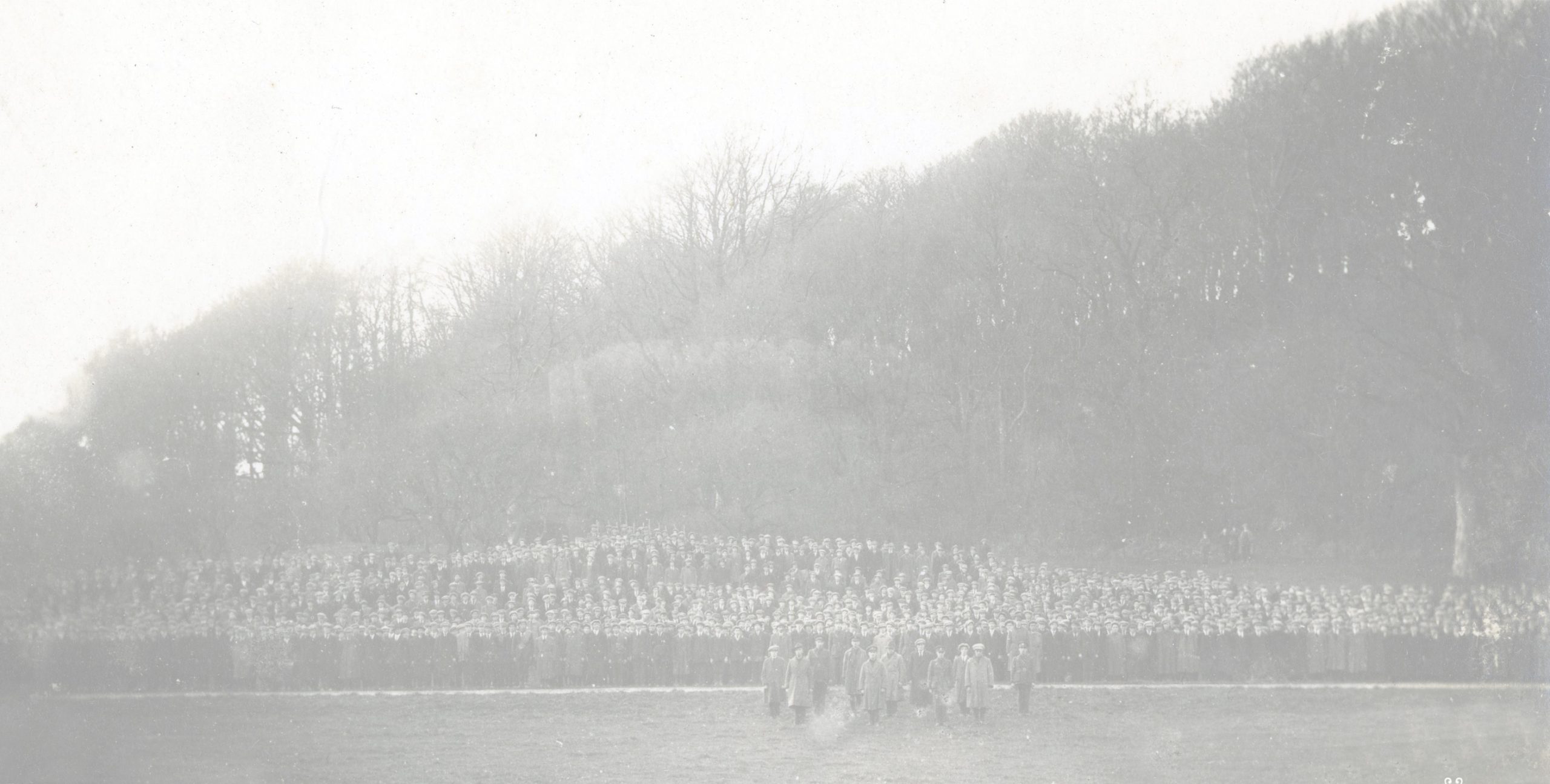John Keane was born on 6th May 1903 to John & Maria [Joyce] Keane in Gortaroe, one mile outside Westport. He was always called Jack. He had an older step-sister, an older sister and he was the middle child of seven consecutive sons. Because he died at such a young age we know very little about his activities in the War of Independence but we do know that he took part in the Kilmeena ambush and had a very narrow escape when a bullet pierced the peak of his cap. This is referenced in his obituary which appeared in the Mayo News. We also know that he took part in the Carrowkennedy Ambush where he was given a gun in surrender but we do not know by whom. One hundred years later we still have the gun. He was greatly influenced by his neighbour Joe Ring and after the War of Independence they both took the Free State Side and he was one of those who assisted Joe Ring in setting up the new Civic Guard. His Garda Reg. Number was 7. Jack died of T B at the age of 20 having attained the rank of Superintendent. He did not have the opportunity to commit his memories of the War of Independence to paper like some of the other Men of the West did so he has been forgotten outside of the family circle. According to his obituary he was so well respected that his coffin was carried shoulder high from St. Mary’s Church in Westport to his grave in Aughavale Cemetary in 1924 by both Free State and Republican supporters. It is amazing then that less than 100 years later he has gone completely from everyone’s memory
However someone did remember – in 2012 Michael Farrell contacted us looking for information on Jack. We knew Jack had been engaged to a lady from Crossmolina but we did not know her name. It turned out that she was Helena O’Reilly and she was Michael’s mother. Michael is a man with a real interesting history from a Civil Rights Activist to a long career in the Law particularly in the area of Human Rights. He had done some research on Jack and we were amazed at all the information he had managed to find. At Christmas 2012 he put together all the information he had collected for his own family and he sent us a copy – we think it’s a good read.
Click to View
- Jack Keane – Portrait
- Jack Keane – Uniform
- Supt Jack Keane
- Jack’s Gun
- Helena O’Reilly
- Memorial Card
- Headstone
- Death of Jack Keane, Irish Independent 24Jan1924
- Jack Keane funeral Jan 1924
Tom Heavy Interview
Click to View
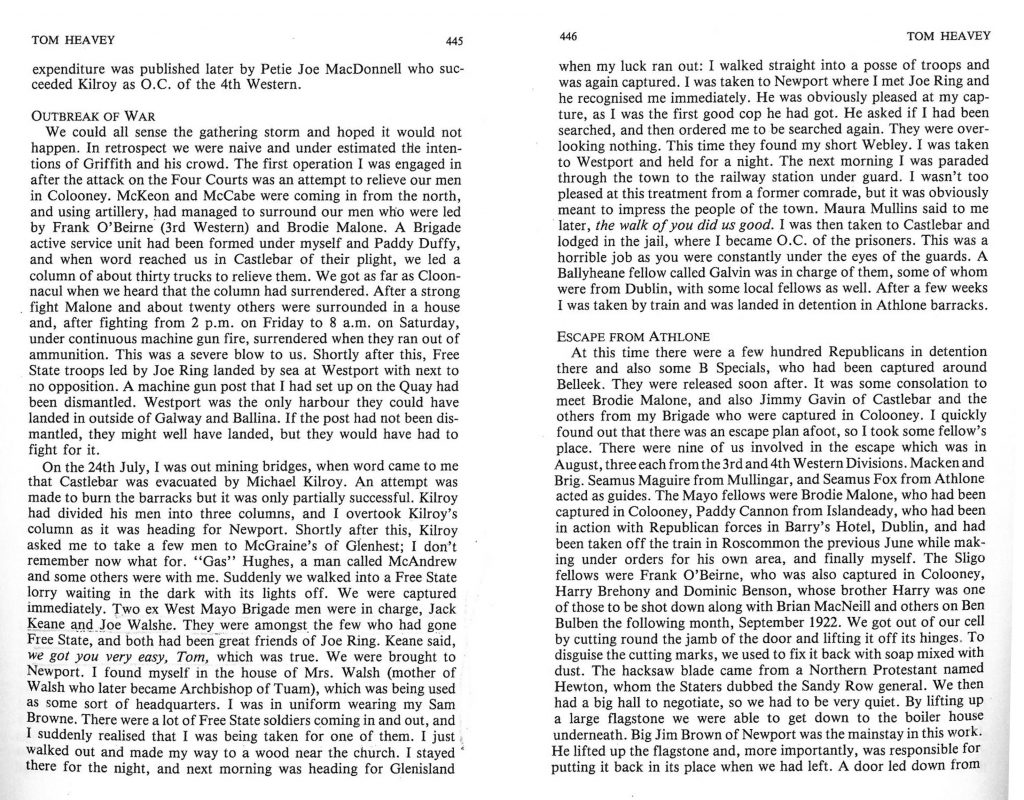
Long Ago in Crossmolina
When my mother was ill and had time to talk, she began to speak about her youth in Crossmolina. She said that she had been engaged to a young former IRA volunteer and officer in the Free State Army who had gone on to become one of the first Superintendents in the new Civic Guards. He was called Jack Keane and he seems to have been billeted for a time in the outbuildings at the back of her father’s shop and house.
She remembered that he had a fine mop of dark hair and always seemed to be washing it at the pump in the yard. He died young, before they could get married. She believed it was from TB and she thought he had got it from the damp and the cold lying out in the Mayo bogs when he was on the run during the War of Independence and again during the Civil War.
Later on I found a photograph, tucked into her photo album, of two young men in military uniform and on the back, in her handwriting, it said: “Chief Superintendent Jack Keane of the Civic Guards”. I didn’t know which of them was Jack Keane and it didn’t say who the other one was. Eventually I learned that Jack Keane was the one on the right of the photo
For years I thought no more about it and she was not there to ask any longer. Then I saw an old photograph in a book of the West Mayo Flying Column of the IRA with the names given underneath. A copy of the photograph had hung in the corridor upstairs in the old family home in Crossmolina. I had vaguely wondered why it was there but had not paid much attention to it.
Now, looking at the names, there he was: Jack Keane, right in the middle of the photo, clutching a rifle and with the mop of dark hair that had caught the attention of the young Lena O’Reilly (my mother) all those years ago.
By then I had got interested in finding out more about my mother’s brother Jack O’Reilly, who had also been involved in the IRA in the War of Independence. He had quarrelled with his father and went to England after the Truce in 1921. My mother had taken her father’s side and never saw him again. She wanted to contact him when she was ill and when I went to work in London in the summer after my last year at school, she gave me an address to go and see him.
I went alright, but there was no-one there. It was a block of council flats and the neighbours were cagey and would not say who lived at the address I had. I left a note but we never heard from him and my mother died not long afterwards. Jack O’Reilly did return to Crossmolina without warning a few years later but I never met him.
I did find out a bit about my uncle Jack through the military records and some years later I thought I would try to look up Jack Keane as well. I reckoned it should be easier. After all, he had been a Garda Superintendent; the Gardai would have to have records about him. I tried the Garda Museum but they said they could not find any trace of him.
I looked up all the books and articles I could find about the IRA in Mayo in the War of Independence but there was no mention of him. I tried the memoirs of veterans in the Bureau of Military History when they were opened to the public, but again there was no sign of him.
I was puzzled and a bit intrigued about how difficult it was to get any information about Jack Keane. I didn’t know how he had ended up billeted in the outbuildings behind the shop in Crossmolina. I sort of assumed he must have been a colleague of my uncle Jack and came from north Mayo or possibly Islandeady, near Castlebar, where Jack O’Reilly had gone on the run, stating with his aunts, who lived there. I got my cousins to ask around but no-one seemed to have heard of Jack Keane.
Then I came across a memoir by Tom Heavey, a prominent Westport IRA man who had taken the anti-Treaty side in the Civil War together with the west Mayo IRA commander Michael Kilroy. Heavey described how, in late July 1922, about a month after the Civil War began, he and a couple of colleagues were travelling by night and on foot when they walked into a lorry full of Free State troops sitting waiting in the dark with the lights switched off.
They were arrested by a young officer whom they knew from the pre-Truce West Mayo Brigade of the IRA. It was Jack Keane. They were still on first name terms and Heavey remarked in the memoir that Jack Keane and another young officer with him had been great friends of Joe Ring, the former IRA commander in Westport, who had taken the pro-Treaty side. They had followed his lead, although the bulk of the West Mayo Brigade had opposed the Treaty.
Heavey was wearing military uniform and there was so much confusion at the time that some of the Free State troops thought he was one of their group and he was able to walk away in the darkness, only to be caught again in the morning.
So, at last I had found a mention of Jack Keane, but there was nothing more. However, at least there was a lead I could follow up. I did some searches for Joe Ring, thinking that might turn up some more information.
Ring was one of a group of pre-Truce IRA officers who had been hand-picked by Michael Collins to set up a new Civic Guard police force to replace the old RIC, which was to be disbanded. He was made commandant of a former British army barracks in Kildare which became the depot for the new Civic Guards. I knew there had been a mutiny by the new recruits, almost all ex-IRA men, in the Kildare depot in May 1922. It was mainly over the employment of a number of ex-RIC men as officers at the depot.
There had been an inquiry into the mutiny and I looked up the report. It was dramatic stuff. The mutineers had elected their own commandant and had taken over the barracks and seized the armoury. They had put the Commissioner of the force, Michael Staines, out of the depot and Joe Ring and some of his fellow Mayo men were besieged in the commandant’s quarters. An armoured car had been sent down from Dublin and threatened to break down the gates of the barracks. There was a tense stand-off.
The inquiry report recorded the evidence of the participants and there among the witnesses was Jack Keane, described as a Superintendent in the Civic Guards.
He was asked about an exchange at the door of the Commandant’s quarters:
“Did you pull a bomb out of your pocket? Yes. I had a bomb in my hand.
“And you made a remark that you would make pieces of some one? I said I was going to defend myself”.
Fortunately it did not come to that. Later on Jack Keane got away through some wire at the back of the barracks while one of his colleagues held up the mutineers’ guards. He got the train to Dublin and reported to Commissioner Staines. By then there were negotiations going on and the mutiny was defused. A month later the Civil War broke out and Joe Ring became a Brigadier in the Free State Army, bringing Jack Keane and his other Mayo colleagues with him.
So I had found some more information about Jack Keane after all, but then the trail went cold again. I did not even know where he came from, but then it struck me. I had been looking in the wrong part of Mayo. He was a close friend and colleague of Joe Ring, who was from Westport. It was most likely he came from the Westport area as well.
I emailed the Westport Heritage Centre, whose journal had published a number of articles about locals involved in the War of Independence and Civil War. I wasn’t expecting much but they got back to me within days.
Yes, they knew of Jack Keane. He came from the of townland of Gortaroe, just outside Westport and Joe Ring had lived about half a mile away, so it was not surprising that he was so close to Ring and followed him into the Civic Guard and the Free State Army. They had a note that there was an item about his death in the Mayo News in January 1924 but beyond that, they did not know much about his career. They did not think there were any members of the family left in the area.
The date was quite a surprise. Calculating from my mother’s age and when I thought she was likely to have got engaged, I had assumed he had died later in the 1920s. Maybe they had got the date wrong but I would try it anyway. The archives of the Mayo News were hard to access but with that date I found a short report about Jack Keane’s death in the Irish Independent. There was quite a lot in it.
It said Jack Keane had joined the Volunteers (later the IRA) in the Westport area at the age of 17 and had served with Joe Ring’s unit. He had taken part in a substantial ambush on an RIC patrol at Carrowkennedy, south of Westport, in early June 1921. In the early days of the Civil War he had been part of a Free State force led by Joe Ring, which had staged a seaborne landing at Westport on 24th July 1922, just days before Jack Keane had arrested his former colleague Tom Heavey.
Two weeks later Jack Keane was involved in another seaborne landing; this time at Youghal as part of a large Free State force which captured Cork City from the anti-Treaty forces. I read about the landing afterwards. There was some fierce resistance to the main force which landed in Passage West, outside the city, but Jack Keane’s group met little resistance.
That was all the report said about the Civil War. It went on to say that he had been appointed Superintendent of the Civic Guards in Cavan/Monaghan but that his health had broken down. He had gone to the south of France to recover but had died shortly afterwards.
Then my cousin Thomas Connor got a copy of the obituary in the Mayo News. It added that Jack Keane had taken part in an ambush of RIC men at Kilmeena, between Westport and Newport, in May 1921, two weeks before the engagement at Carrowkennedy. The flying column had taken heavy casualties at Kilmeena and Jack Keane had had a lucky escape as a bullet had passed through his cap.
The Mayo News said he was given a military funeral in Westport and that among all the Government soldiers and Civic Guards, a number of young men who helped to carry the coffin were anti-Treaty Republicans who had only recently been released from prison by the Free State authorities. They were paying tribute to a former comrade from the War of Independence. He was buried in Aughaval graveyard outside Westport. The paper recorded that he was survived by his parents John and Maria Keane, his sister Annie and his brothers Stephen and Patrick.
There was no mention of his fiancée but women did not play much part in funerals in those days and fiancées were probably not counted at all.
There was nothing else about the War of Independence or Civil War, but I could fill in a few details from other sources. Jack Keane had played an important part in the successful battle at Carrowkennedy and he had approached a house in which the RIC had taken cover to call on them to surrender, which they did. And it was as the column moved away from West Mayo to escape the inevitable hue and cry that the photograph of the West Mayo Flying Column with Jack Keane in the centre was taken near Lahardane, about ten miles from Crossmolina, by Jack Leonard, a local IRA member and professional photographer.
The photograph was poignant because it included both Joe Ring and Michael Kilroy, the Commandant of the West Mayo Brigade as comrades in arms. A little over a year later, in mid-September 1922, about six weeks after he and Jack Keane had landed at Westport with 400 Free State troops, Joe Ring was killed in a battle with his former comrades outside Ballina. And two months later, Kilroy was wounded and captured by Free State forces near his home area of Newport while another ex-West Mayo Brigade member was killed on the Free State side during the shoot-out.
There was still no mention of Jack Keane and Crossmolina, however, so all I could do was speculate. Free State troops took over the town in August 1922 and established a garrison there, using it as a gateway to the rugged territory of Erris, to which the anti-Treaty forces had retreated. Presumably Jack Keane returned from Cork at some stage and joined the
troops in Crossmolina, where he was billeted in the out-buildings of my grandfather Patrick O’Reilly’s shop and pub in Church Street. And that must have been when Patrick’s daughter Lena watched the young officer washing his hair at the pump in the yard.
With the date of Jack Keane’s death and details of where he came from, I contacted the Garda Museum again. This time they did find some records and came back with a little more information. He had joined the Civic Guards on 23 March 1922 and was promoted to Inspector a week later on 1st April. He was promoted to Superintendent a month later, on 1st May and two weeks later he was caught up in the mutiny in the depot in Kildare.
The Garda Museum did not seem to have any information about Jack Keane joining the Free State Army in June or July 1922 or when he returned to the Civic Guards, presumably some time in 1923. He was discharged from the Guards as “medically unfit” on 11th January 1924 and he died less than two weeks later.
But the most striking piece of information was Jack Keane’s date of birth. He was born on 6th June 1903. I thought it might have been a mistake but I cross-checked it with the 1911 census and it tallied. That meant he was not quite 18 when he was involved in the ambushes at Kilmeena and Carrowkennedy and not yet 19 when he was appointed a Superintendent in the Civic Guards in May 1922.
He was just 19 when he landed at Westport with Joe Ring and the Free State troops in July 1922 and in Youghal, two weeks later, and he was still only 20 when he died in January 1924.
And what about my mother, Lena O’Reilly? She was born in February 1906 and was just under 18 when her fiancé died in January 1924. She must have been 17 when they got engaged. What an extraordinary story had lain behind the fragments of information I had picked up from my mother in her last illness and the photograph I had found of those two young men in their military uniforms.
But the story was to take another turn before it was finished. The Westport Historical Society emailed me again to say that their chairman was from Gortaroe, the area that Jack Keane came from, and that he knew a member of the Keane family who was still living there. I sent him all the information I had and asked him to pass it on if he thought the family would be interested.
A few weeks later I received an email from Patricia Keane O’Malley, a niece of Jack Keane, the daughter of his younger brother Stephen. She was eager to talk about him.
It was another couple of weeks before I was able to ring her. She had been amazed to get my emailed note to the chairman of the Historical Society. She said her father had nearly worshipped his brother Jack and often talked about him but she had never thought to question him about it until it was too late. Her father had died in 1984 and was the last member of the family who had known Jack.
He had told them that Jack lied about his age to be allowed to join the Volunteers in 1920 when he was still probably only 16. He had been very active despite his age and had played a significant role in the ambush at Carrowkennedy. Her father thought it was Jack who had actually taken the surrender of the RIC men there and years later they had found a rusty old revolver hidden in the house which they thought might have belonged to the RIC officer who had surrendered.
Patricia said they had been told as children that Jack had been engaged to a girl from Crossmolina but they had never known her name.
In later years she had tried to find out more about her uncle Jack and had made enquiries from the Gardai and the Army but, like me, she had found out very little. She had looked at all the books and articles about the period and had read Michael Kilroy’s memoir from the Bureau of Military History but there was no mention of Jack Keane.
One of the only bits of information she had from outside her family circle came from a poignant source. As children they used to go into a shop in Westport owned by a man called Joe Baker, who would ask their names and tell them that he knew their uncle Jack. He said say how sad it was about his early death and what a lovely young fellow he had been. Joe Baker had been a leading member of the West Mayo Flying Column in the War of Independence but had been on the other side from Jack in the Civil War.
Patricia said she had almost begun to wonder whether all they had heard in the family about her uncle Jack had been made up or whether he had been deliberately airbrushed from history until I had made contact with her and that she had learned more about him in one phone call than in most of her life up to then.
It was a strange experience speaking to the niece of the man my mother had wanted to marry almost 90 years ago when she was just 17. Patricia had jokingly called me her new cousin and I had wondered about the emotions that had lain behind that creased and battered photograph that my mother had carried with her since she was a girl in Crossmolina all those years ago.
Michael Farrell December 2012
Attached photographs:
Jack Keane in his Civic Guard uniform with a friend Helena (Lena) O’Reilly in the early 1920s
Jack Keane Evidence to Civic Guard Inquiry
Click to View
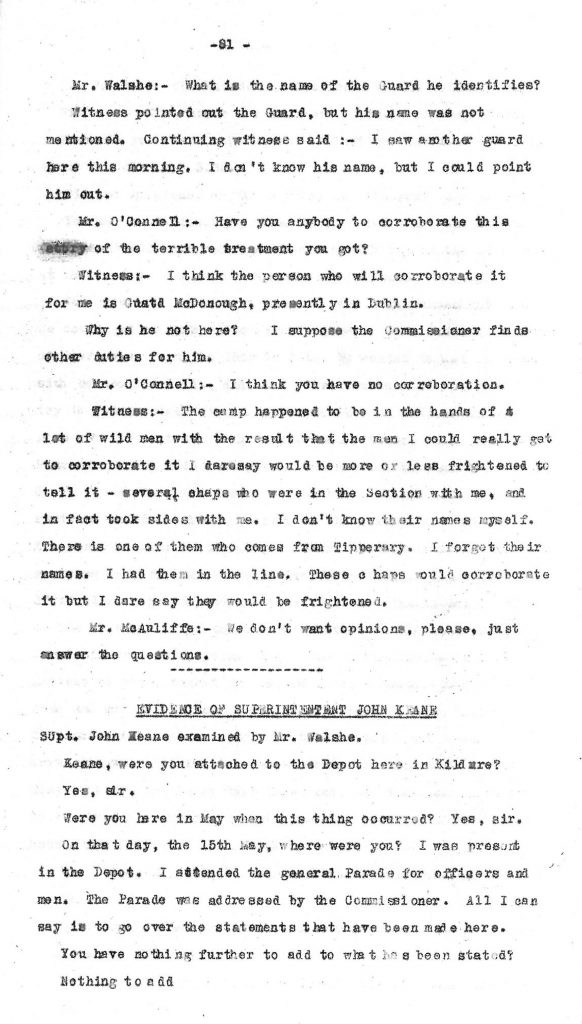
Obituary
Death of Mr. John Keane (Jr) Gortaroe, Westport
26th January 1924
Much sympathy is felt for Mr. John Keane, Gortaroe, Westport, on the death of his son, Mr. John Keane Jr. Superintendent in the new Civic Guards. He was a young man about 20 years of age and in his short life he gave proof of courage and daring in an effort to rid his country of a foreign domination. As a member of the flying column of the I.R.A. he commanded the respect and esteem of his companions in arms and was Captain in the Republican Army. In engagements round Westport and in other places he had very many narrow escapes. In the battle of Kilmeena the peak of this cap was pierced by an enemy bullet. He came unscathed through all that trying time and later was appointed Superintendent of the newly formed Civic Guard.
High Mass de requim was celebrated for the repose of his soul in Westport Parish Church on Monday and the funeral to Aughavale on that day was a very striking manifestation of the regard in which he was held. A long line of men who had been actively associated with the deceased in the old I. R. A. bore the coffin on their shoulders all the way from the church to Aughavale, a distance of three miles. Members of the local Civic Guards and military with a firing party also marched in procession behind the bier. A remarkable feature of the funeral was that a large number of Republicans recently released from prison by the Free State Government were amongst those who bore the remains to their last resting place.
At the grave the military firing party fired three volleys and the Last Post was sounded.
The chief mourners were: John Keane (father); Mrs. John Keane (mother); Annie Keane (sister); Stephen Keane and Patrick Keane (brothers).
Mr. and Mrs. Keane desire to return their sincere thanks to the many who sent them letters and messages of sympathy in their great sorrow. R. I. P

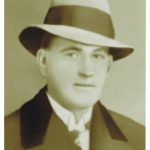
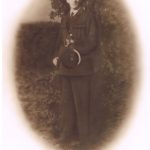
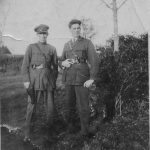
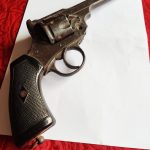
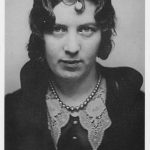
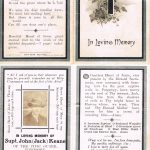
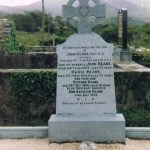
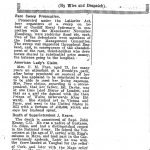
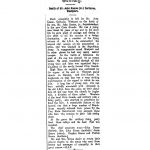
 www.westportheritage.com
www.westportheritage.com